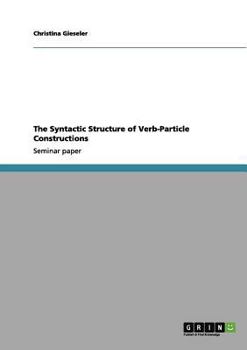The Syntactic Structure of Verb-Particle Constructions
Seminar paper from the year 2011 in the subject English Language and Literature Studies - Linguistics, grade: 1,0, University of Wuppertal, language: English, abstract: Introduction Verb-Particle Constructions occur in "most, if not all, of the Germanic languages" (Deh 2002:1, Olsen 2000:149). They are also known as "verb-particle combinations", "phrasal verbs", "particle verbs" (PVs) or "separable (complex) verbs" (cf. Deh ibid., cf. Deh , Jackendoff, McIntyre, Urban 2002:1). VPCs formally consist of "a verbal stem and an intransitive prepositional or adverbial element", a so-called particle (Olsen 2000:149). In linguistic research, "there is no uncontroversial definition of particles which reliably demarcates them from similar items and has cross-linguistic validity" (Deh et al. 2002:3) ...] According to Deh (2002), "the perhaps most striking property of transitive PV's in English is their appearance in two alternating orders" (3) as the English particle "can appear on either side of a direct object, unless it is a (non-contrastively accented) pronoun" (Deh et al. 2002:2, cf. Jackendoff ibid.). In the so-called continuous order the particle is "adjacent to the verb and precedes the DP-complement" as in (1) (Deh 2002:3-4). In the discontinuous order "the particle follows the DP-object" (cf. 2) (ibid.). In this order the use of unstressed pronouns is obligatory as illustrated in (3) (ibid.; the following examples are borrowed from Deh ibid. as well). (1) He wiped off the table. (2) He wiped the table off. (3) a. He wiped it off. b. *He wiped off it. Concerning the syntactic structure of English VPCs, several questions might be asked: 1. How does the syntactic structure of VPCs in English look like? 2. How do the alternating word orders come about? 3. Which of the word orders is the underlying one? Linguists have developed many different approaches to the syntactic structure of VPCs. This paper is going to focus attention on thr
Format:Paperback
Language:English
ISBN:3656122725
ISBN13:9783656122722
Release Date:February 2012
Publisher:Grin Verlag
Length:56 Pages
Weight:0.19 lbs.
Dimensions:0.1" x 5.8" x 8.3"
Customer Reviews
0 rating





